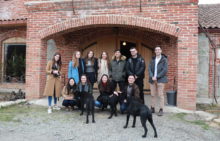Cheese and Georgia were never synonymous in my mind until I was sat across my classmates at the dinner table on the sixth night in Tbilisi as Daria encouraged us to “eat more cheese!” – words which have become rather comforting. Daria Dumbadze was one of three trip supervisors, alongside Professor Robert Austin and a fellow Georgia international course module (ICM) and University of Toronto alum, David Kitai.
Before I provide a colorful list of memories and experiences, I should mention the purpose of the week-long trip. The annual journey to Tbilisi is an ICM taught by Professor Austin, titled “Enlarging Europe: The European Union and Its Applicants,” and is part of a third-year course at the St. George Campus. Each year, a small group of students may apply to embark on this adventure. Students are required to propose a research project focusing on specific aspects of Georgia and relate them to the bigger picture of Georgia-EU relations. Past research projects have been based on topics as diverse as internally displaced persons, judicial reform, Georgian wine, minority rights, domestic violence, and cybersecurity, to name a few. My project focused on Smart City initiatives in Tbilisi and specifically how Soviet-era architecture affects city planning and transportation.
Our week was packed with interviews and meetings, each pertaining to our own stream of research. My classmates and I created packed schedules full of interviews with a wide variety of stakeholders. As I undertook my own meetings, I quickly became very grateful for the helpful disposition of Georgian people, who helped me identify further interviewees after we were already on the ground. This left me with a great scheduling opportunity: a full day exploring Tbilisi.
It was a beautiful Wednesday, and after a group meeting at the Ministry of Foreign Affairs, I headed to the Old City with my classmate, Ema, to take the famous cable car up to the Old Fort named Narikala. On the way up, I got a great view of the city’s architecture and, at the top, another view overlooking a prime example of Georgian bazaar culture. The marketplace’s pathway was lined with small stands selling an array of trinkets, souvenirs, and snacks. In the background, a musician serenaded the public with his accordion, playing the famous Soviet-era Alla Pugacheva song, “Million Roses.” With that soundtrack in my head, I headed into the bazaar.
The Dry Bridge Bazaar is one of the largest and most interesting bazaars in Tbilisi, with merchants selling everything from silverware and dining sets to auto parts and Soviet memorabilia (the latter two sometimes overlapping). Aside from the fun I had negotiating prices in Russian, one thing at the bazaar was priceless: the conversations I had with the people there. I spoke to some who mourned the end of the Soviet era, some who kindly recommended a variety of places to visit on the periphery and beyond Tbilisi, and some who simply told me about the items they were selling and what their current lives were like. Most notably, I spoke to Dima, a Georgian man who was selling an assortment of Soviet paraphernalia. I was interested in one of the Soviet-era pins he had on display, which led him to tell me a story. The restaurant across the bridge, he said, once served a group of Soviet officials who left mid-dinner, flew back to Moscow for business, and flew back to finish their meal – all in a day’s work.
Sadly, Dima’s stories were not all such fun musings. His tour of his Soviet wares ended with him showing me his own diploma, saying, “Never in my life did I think I was going to be selling my diploma,” an artifact of the past. It was for sale for a mere 15 lari – roughly 7 dollars. I cheekily remarked, “It should be 10 since its only blue, not red” – the difference between red and blue being that red signified high distinction in the Soviet Union, whereas blue was a regular diploma. We both laughed. I ended up purchasing two diplomas from him as well as a few pins. Interactions like these which coloured my experience in Georgia.
I spent the evenings sharing experiences with my classmates over dinner. Since all of us had dramatically different days, the dinner table was never dull, even when we felt like we could not possibly consume any more cheese. I think it is safe to say that everyone learned more than we could have hoped for during our stay. Now that we are back in Toronto, each of us is crafting an essay based on the research we conducted in and outside of Tbilisi.
The trip would not have been possible without the support of Robert Austin, Daria Dumbadze, David Kitai, and Jennifer Bahn, another University of Toronto alumna. On behalf of all the Georgia ICM students, I would like to extend a very big thank you to all who guided us through this adventure.
And last, a tip: If you ever find yourself in Georgia, arrange a day where you try all the different kinds of khachapuri whilst chatting with Georgians. You are guaranteed a great time. Needless to say, Georgia has a lot of soul, and once you experience it yourself, it will be easy to see why so many people love it.
by Arina Dmitrenko, CERES European Studies minor and President, European Studies Students’ Association
See our Facebook album for more photos, provided courtesy of student-travellers Adhele Tuulas, Teah Pelechaty, and Gigi Chan.
